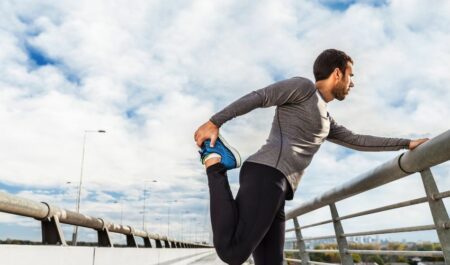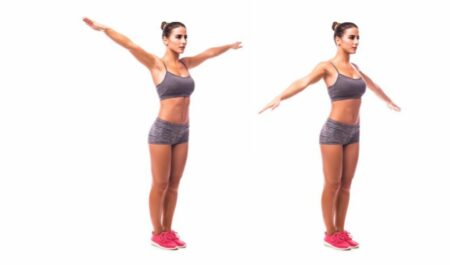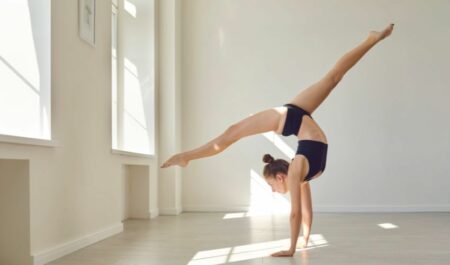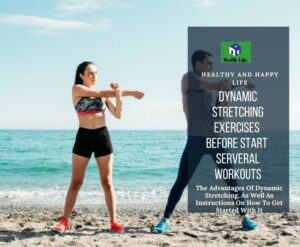Active stretches, also known as dynamic stretches, involve moving the joints and muscles through their complete range of motion. They might be utilized to assist in getting your body warmed up prior to engaging in physical activity. In here we are going to examine what are the dynamic stretching exercises and what advantages can expect this dynamic stretching exercises.
The movements that you will be performing in the activity or sport that you are about to participate in can be mimicked by performing dynamic stretches. Before entering the water, a swimmer might, for instance, rotate their arms in a circular motion.
Before beginning any kind of exercise, you should warm up your muscles with a series of dynamic stretches. Dynamic stretches can also be thought of as a series of movements. Exercises such as twisting the trunk, walking lunges, and leg swings against a wall are some examples.

Stretching Can Either Be Dynamic Or Static.
Stretching in a dynamic manner is distinct from stretching in a static manner.
Stretches that get the body moving are called dynamic stretches. The stretches are not held for any significant amount of time at any point. Stretches that involve movement, such as lunges with a torso twist, are known as dynamic stretches.
On the other hand, a static stretch is one in which the muscle is extended and kept in that position for a set amount of time. Triceps stretches and butterfly stretches are two examples of stretches that are considered to be static.
When Can I use dynamic Stretching Exercises?
Before beginning any type of fitness routine, it is a good idea to warm up with some dynamic stretching. It has the potential to assist in warming up your body or in getting your muscles active and prepared for action. The following are some examples of activities that could benefit from dynamic stretches:
Before participating in sports or athletics Researchers have found that athletes who would be engaging in activities that require running or jumping, such as basketball players, soccer players, and sprinters, may benefit from performing dynamic stretches.
Before attempting to lift weights. When compared to static stretching or not stretching at all, research suggests that dynamic stretching may aid enhance performance and leg extension power more so than static stretching or not stretching at all.
Before cardiovascular exercise. Dynamic activities can get your muscles warmed up and ready, which can potentially improve performance and lessen the risk of injury. This is true whether you’re going to be running, participating in boot camp, or swimming.
Getting Warmed Up With Some Dynamic Stretches.
Before beginning an exercise routine, you should warm up with some dynamic stretching. The following are some examples of moves that might be included in a dynamic stretching routine.
Hip Circles.
- Maintain balance by standing on one leg while grasping a countertop or a wall for support.
- Move your other leg to the side by gently making little circles with it out to the side.
- Perform 20 revolutions, then switch your standing leg.
- As your flexibility improves, progress to larger and larger circles.
A Lunge With A Twist.
- Move forward on your right leg while maintaining a position in which your knee is directly over your ankle and does not extend any further than your ankle.
- Make a reaching motion toward the ceiling with your left arm while bending your torso to the right.
- To return to a standing position that is more upright, bring your right leg back behind you. Put your left leg in front of you and lunge forward.
- Perform the exercise five times for each leg.
Arm Circles.

- Maintaining a stance with feet apart at the width of a shoulder and arms held out to the side at shoulder height
- Make a leisurely circle around your arms, beginning with smaller circles and working your way up to larger ones. Perform 20 circles.
- Perform 20 more revolutions in the opposite direction of the circles.
Runners Should Perform Dynamic Stretches.
Warming up with some dynamic stretches might be beneficial for runners. The following are some stretching exercises that are suggested for runners.
Large Arm Circles.
- Maintain an upright stance while extending your arms out to the sides of your body.
- Begin by drawing huge circles in the air.
- Perform five to ten repetitions with your arms moving forward in a swinging motion.
- Repeat the motion while swinging your arms backward.
Leg Pendulum.
- While maintaining your balance on the other leg, begin to swing the leg that you are balancing on back and forth. If necessary, you can use a wall for support.
- Perform this movement five to ten times in each direction.
- Repeat the motion with the opposite leg and swing back and forth between five and ten times.
- After that, you can turn your back to the wall and move your legs in a side-to-side motion if you so choose.
Jog To Quad Stretch

- To get started, jog in place for two to three seconds.
- To stretch out the quadriceps, reach behind one leg and get hold of the foot of the opposite leg. Hold for two to three seconds.
- Restart your jogging for the next two to three seconds.
- Perform the stretches on the other leg as well.
- Repeat between 5 and 10 times.
Stretches With A Dynamic Element For The Upper Body
Before working out your upper body, such as before weightlifting, you could find it beneficial to engage in some dynamic stretching. You might want to give the following dynamic stretches a try.
Arm Swings.
- You should be facing forward with your palms facing down while standing with your arms extended in front of you at shoulder height.
- You should be walking forward while swinging both of your arms to the right. Your left arm should be reaching in front of your chest, and your right arm should be reaching out to the side. When you swing your arms, it is important to remember to keep your torso looking in the same direction and to simply spin your shoulder joints.
- As you continue walking, switch the swing’s orientation so that it goes in the opposite way.
- Perform this step five times on each side.
Spinal Rotations.
- You should be standing with your feet about the width of a shoulder apart, and your arms should be brought out to the side and up to shoulder height.
- Holding your torso steady, begin to slowly rotate your body from right to left as you continue to keep your torso still.
- Repeat between 5 and 10 times.
Is It Possible To Employ Dynamic Stretching As A Method Of Cooling Down?
It is recommended to conduct dynamic stretches as part of a warm-up routine; however, it is not essential to do so as part of a cool-down routine. Your core temperature will rise as you perform dynamic stretches. The purpose of a cooldown is to bring down your internal body temperature.
Instead, you should try out some static stretches like a hamstring stretch, a cobra stretch, or a quadriceps stretch.
Is It Safe To Do Dynamic Stretches?

In the event that your physician or physical therapist advises you to do so, you should never practice dynamic stretches while you are injured.
When performing dynamic stretches, older adults (over the age of 65) should also exercise caution. It’s possible that static stretches are more useful.
Gymnastics, ballet, and yoga are all examples of activities that need flexibility, therefore static stretching may be more effective for these activities.
The Final Thought.
You should try include some dynamic stretches in your warmup the next time you go to the gym or play sports. It’s possible that after stretching, your body will feel more invigorated, stretched out, and ready to carry you through the rest of your workout. Just keep in mind that you should see your physician before beginning any new form of physical activity.
FAQs.
What are the benefits of dynamic and static stretching?
Stretching on a daily basis is beneficial for everybody, regardless of their level of fitness or level of experience in the athletic world. You may enhance your range of motion, your posture, and your mental state by including between five and ten minutes of both dynamic and static stretching in your daily workout routine.
Why is it important to do dynamic stretching before exercise?
It is important to put an emphasis on dynamic stretching if you are doing a warm-up for a workout or a sporting event. Your range of motion and flexibility will both increase as a result of this. It gets your blood flowing and gets your muscles ready to work while also warming up your body. It has also been demonstrated to lessen the likelihood of sustaining an injury.
Why is dynamic stretching better than static stretching?
“Dynamic stretches will trigger reflexes in your tendons and muscles, and they can also help your body detect, via movement, its position in space” “Rather of depending just on visual signals, dynamic stretches can assist your body recognize its place in space through movement.” When performed in conjunction with some light movement that gets the heart pumping, static stretching can be an effective warm-up for exercise.
Is dynamic stretching good before workout?
Before beginning any type of workout regimen, whether it be sports, weightlifting, jogging, or any other form of cardiovascular exercise, it is important to warm up your muscles with some dynamic stretches. The body is sufficiently warmed up, your muscles are activated, and your body is prepared to operate when you perform these stretches.
